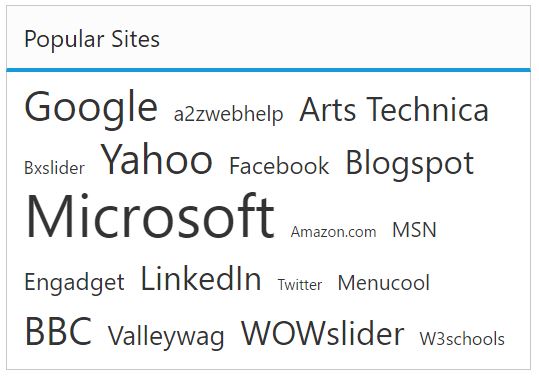Getting Started
20 Jul 201711 minutes to read
This section explains briefly about how to create a TagCloud in your application with Angular. The TagCloud can be easily configured to the div element in which the tags are placed. The following screenshot illustrates the functionality of a TagCloud widget with a list of the topmost search engines.

Create TagCloud widget
Create an HTML page and add the scripts references in the order mentioned in the following code example.
<!DOCTYPE html>
<html>
<head>
<link href="//cdn.syncfusion.com/14.3.0.49/js/web/flat-azure/ej.web.all.min.css" rel="stylesheet" />
<script src="node_modules/core-js/client/shim.min.js"></script>
<script src="node_modules/zone.js/dist/zone.js"></script>
<script src="node_modules/reflect-metadata/Reflect.js"></script>
<script src="node_modules/systemjs/dist/system.src.js"></script>
<script src="https://code.jquery.com/jquery-3.0.0.min.js"></script>
<script src="http://cdn.syncfusion.com/14.3.0.49/js/web/ej.web.all.min.js" type="text/javascript"></script>
<script src ="http://cdn.syncfusion.com/14.3.0.49/js/common/ej.angular2.min.js"></script>
<script src="systemjs.config.js"></script>
</head>
<body>
<ej-app>Loading...</ej-app>
</body>
</html>Add necessary HTML elements to render TagCloud
<ej-tagcloud id="tag" titleText="Popular Sites" [dataSource]="list"></ej-tagcloud>Add the following code example to add list of items to the TagCloud and initialize the TagCloud widget.
import {Component} from '@angular/core';
@Component({
selector: 'sd-home',
templateUrl: 'app/components/tagcloud/tagcloud.component.html'
})
export class TagCloudComponent {
list: array;
constructor() {
this.list = [
{ text: "Google", url: "http://www.google.co.in", frequency: 12 },
{ text: "a2zwebhelp", url: "http://www.a2zwebhelp.com", frequency: 3 },
{ text: "Arts Technica", url: "http://arstechnica.com/", frequency: 8 },
{ text: "Bxslider", url: "http://bxslider.com/examples", frequency: 2 },
{ text: "Yahoo", url: "http://in.yahoo.com/", frequency: 12 },
{ text: "Facebook", url: "https://www.facebook.com/", frequency: 5 },
{ text: "Blogspot", url: "http://www.blogspot.com/", frequency: 8 },
{ text: "Microsoft", url: "http://www.microsoft.com/", frequency: 20 },
{ text: "Amazon.com", url: "http://www.amazon.com/", frequency: 1 },
{ text: "MSN", url: "http://www.msn.com/", frequency: 3 },
{ text: "Engadget", url: "http://www.engadget.com/", frequency: 5 },
{ text: "LinkedIn", url: "http://www.linkedIn.com/", frequency: 9 },
{ text: "Twitter", url: "http://www.Twitter.com/", frequency: 0 },
{ text: "Menucool", url: "http://www.menucool.com", frequency: 3 },
{ text: "BBC", url: "http://www.bbc.co.uk/", frequency: 11 },
{ text: "Valleywag", url: "http://valleywag.gawker.com/", frequency: 6 },
{ text: "WOWslider", url: "http://wowslider.com", frequency: 9 },
{ text: "W3schools", url: "http://www.w3schools.com/", frequency: 2 }
];
}
}The following screenshot displays the output of the above code example.

Set Min and Max Font Size
In the above code example, the frequency properties are used to set the min and max font size to the TagCloud list item.
import {Component} from '@angular/core';
@Component({
selector: 'sd-home',
templateUrl: 'app/components/tagcloud/tagcloud.component.html'
})
export class TagCloudComponent {
list: array;
constructor() {
this.list = [
{ text: "Google", url: "http://www.google.co.in", frequency: 12 },
{ text: "a2zwebhelp", url: "http://www.a2zwebhelp.com", frequency: 3 },
{ text: "Arts Technica", url: "http://arstechnica.com/", frequency: 8 },
{ text: "Bxslider", url: "http://bxslider.com/examples", frequency: 2 },
{ text: "Yahoo", url: "http://in.yahoo.com/", frequency: 12 },
{ text: "Facebook", url: "https://www.facebook.com/", frequency: 5 },
{ text: "Blogspot", url: "http://www.blogspot.com/", frequency: 8 },
{ text: "Microsoft", url: "http://www.microsoft.com/", frequency: 20 },
{ text: "Amazon.com", url: "http://www.amazon.com/", frequency: 1 },
{ text: "MSN", url: "http://www.msn.com/", frequency: 3 },
{ text: "Engadget", url: "http://www.engadget.com/", frequency: 5 },
{ text: "LinkedIn", url: "http://www.linkedIn.com/", frequency: 9 },
{ text: "Twitter", url: "http://www.Twitter.com/", frequency: 0 },
{ text: "Menucool", url: "http://www.menucool.com", frequency: 3 },
{ text: "BBC", url: "http://www.bbc.co.uk/", frequency: 11 },
{ text: "Valleywag", url: "http://valleywag.gawker.com/", frequency: 6 },
{ text: "WOWslider", url: "http://wowslider.com", frequency: 9 },
{ text: "W3schools", url: "http://www.w3schools.com/", frequency: 2 }
];
}
}In the above code, the min font size is 0 and max font size is 12.
Set event to perform an operation
Here, you can set the TagCloud events such as create, mouseover, mouseout, click.
<ej-tagcloud id="tag" titleText="Popular Sites" [dataSource]="list" (create)="onCreate($event)" (click)="onClick($event)" (mouseover)="onmouseover($event)" (mouseout)="onmouseout($event)"></ej-tagcloud>import {Component,ViewEncapsulation} from '@angular/core';
@Component({
selector: 'ej-app',
templateUrl: 'app/app.component.html',
})
export class AppComponent {
list: array;
constructor() {
this.list = [
{ text: "Google", url: "http://www.google.co.in", frequency: 12 },
{ text: "a2zwebhelp", url: "http://www.a2zwebhelp.com", frequency: 3 },
{ text: "Arts Technica", url: "http://arstechnica.com/", frequency: 8 },
{ text: "Bxslider", url: "http://bxslider.com/examples", frequency: 2 },
{ text: "Yahoo", url: "http://in.yahoo.com/", frequency: 12 },
{ text: "Facebook", url: "https://www.facebook.com/", frequency: 5 },
{ text: "Blogspot", url: "http://www.blogspot.com/", frequency: 8 },
{ text: "Microsoft", url: "http://www.microsoft.com/", frequency: 20 },
{ text: "Amazon.com", url: "http://www.amazon.com/", frequency: 1 },
{ text: "MSN", url: "http://www.msn.com/", frequency: 3 },
{ text: "Engadget", url: "http://www.engadget.com/", frequency: 5 },
{ text: "LinkedIn", url: "http://www.linkedIn.com/", frequency: 9 },
{ text: "Twitter", url: "http://www.Twitter.com/", frequency: 0 },
{ text: "Menucool", url: "http://www.menucool.com", frequency: 3 },
{ text: "BBC", url: "http://www.bbc.co.uk/", frequency: 11 },
{ text: "Valleywag", url: "http://valleywag.gawker.com/", frequency: 6 },
{ text: "WOWslider", url: "http://wowslider.com", frequency: 9 },
{ text: "W3schools", url: "http://www.w3schools.com/", frequency: 2 }
];
}
onCreate($event)
{
alert();
}
onClick($event)
{
alert();
}
onmouseover($event)
{
alert();
}
onmouseout($event)
{
alert();
}
}In the above code example, the alert() function is used to show the events that happened.